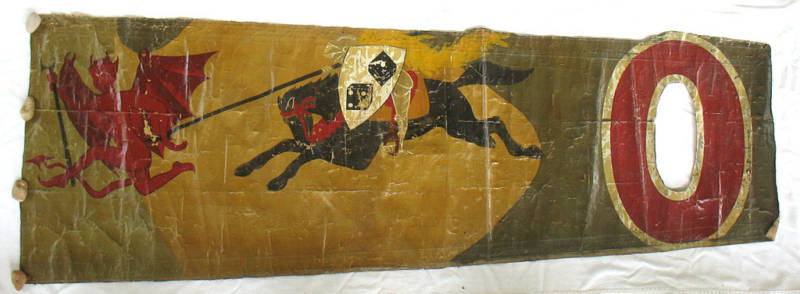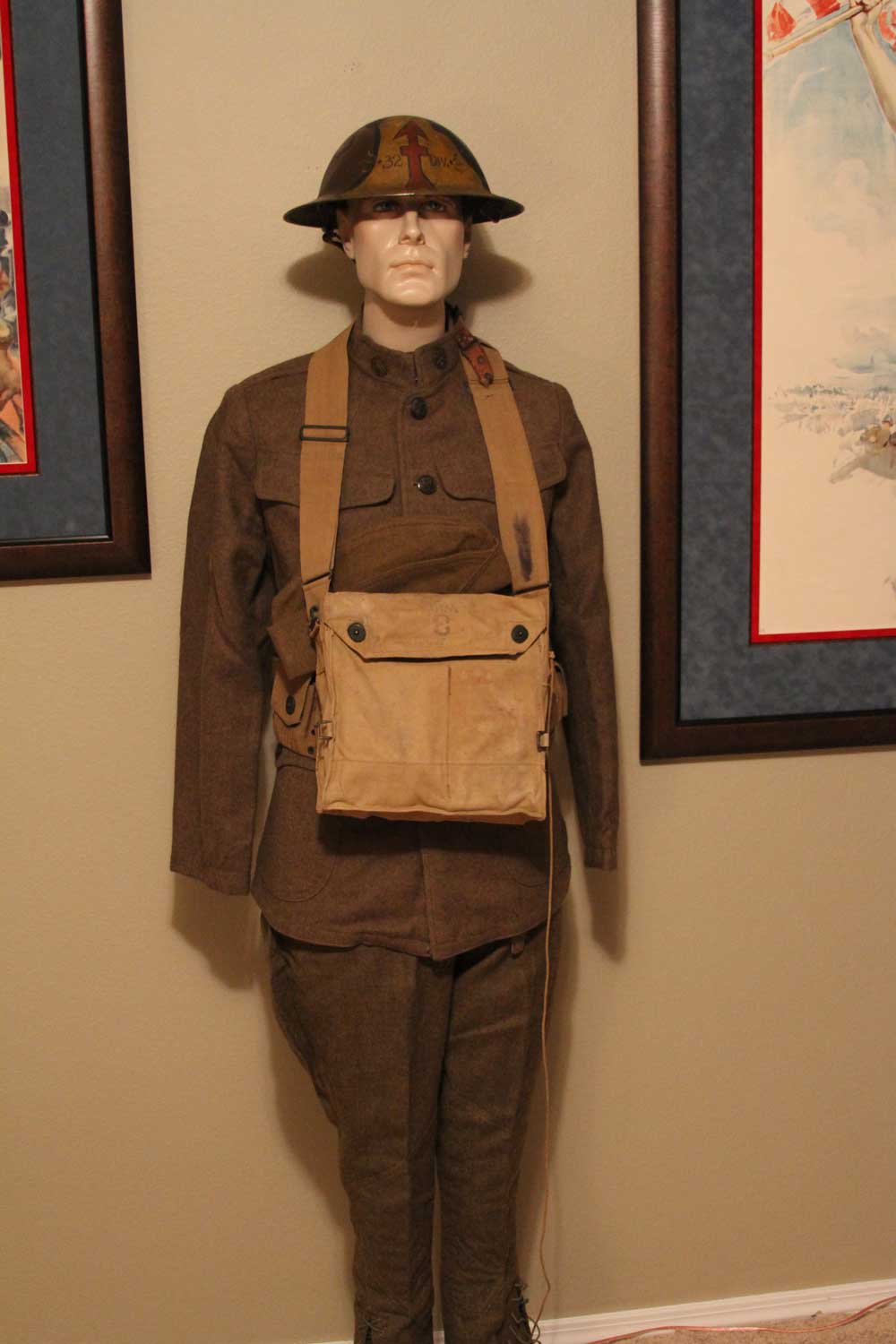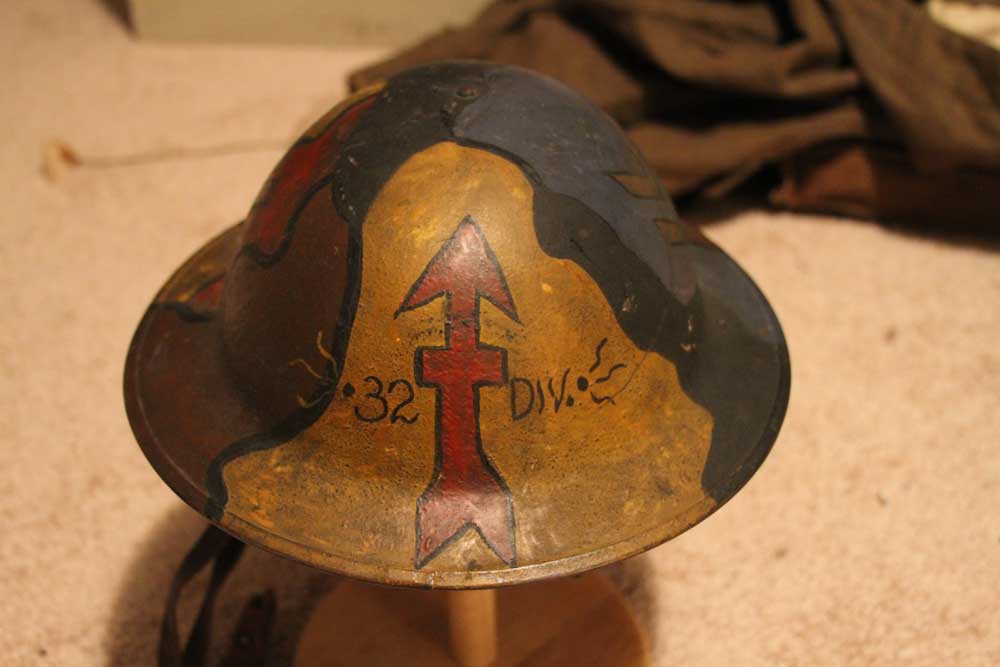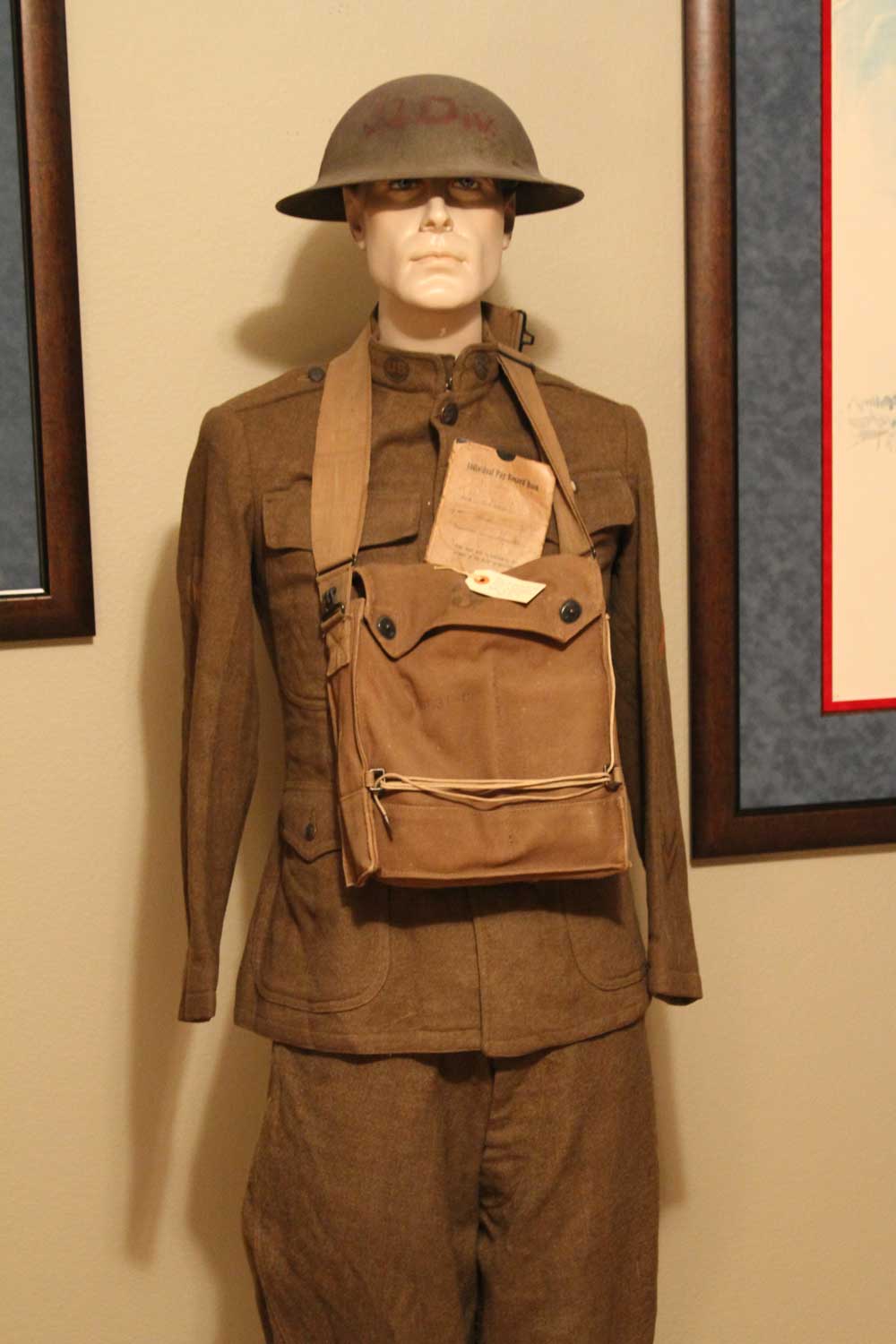-
Posts
1,313 -
Joined
-
Last visited
-
Days Won
4
Content Type
Profiles
Forums
Blogs
Gallery
Events
Store
Posts posted by Chris Liontas
-
-
Does anyone know the award criteria for the Croix de Guerre for US military personel in WWI? I now they were awarded during the war, but why were they awarded in the 20's to US servicemen? I have a copy of a document to Arthur Schaap who seems to be awarded the medal in 1928. Were they awarded via brigade for action during the war?
0 -
I'm pretty sure such wounds have always been eligible. As the original War Department General Order stated, the Purple Heart was open to one with a "wound which necessitates treatment by a medical officer and which is received in action with an enemy..." They probably had a problem with people trying to claim Purple Hearts for wounds which were little more than scratches, so they began cracking down and focusing on how penetrative the wound was. This would have had unintended consequences for some with traumatic internal injuries, so they had to revisit the criteria to make sure deserving recipients weren't accidentally excluded.
The Purple Heart wasn't created until 1932. When adopted, those eligible were those who had received a wound chevron or those who had been awarded a Meritorious Service Citation Certificate by the AEF. Those who received a Citation Certificate for heroism were eligible for the Silver Star, also created in 1932. As noted above, there was also a rule for eligibility for those who might not have had a wound chevron, but could document having been wounded. Sometime early in World War II, they changed the rules to eliminate the meritorious service awards (around the same time they created the Bronze Star?). It wasn't until 1943 that the Purple Heart was extended to the Department of the Navy as well (with retroactive elegibility).
A story which may or may not be true is that the Purple Heart was originally only going to be for meritorious service, but the Army Chief of Staff, Gen. Douglas MacArthur, realized that while he would get a bunch of Silver Stars for his many citations for heroism while serving with the 42nd Division in World War I, he wouldn't get any Purple Hearts. So broadening the pool of eligibility to include those wounded or killed while doing their duty just happened to benefit him. I suppose this story would be appealing to critics of MacArthur who viewed him as a glory hound.
Thanks Dave! I never understood what grounds qualified as meritorius service. This makes more sense.
0 -
Nice tunic. I know where this piece was before it turned up on the collector market within the last six months.

The colored stripe ("Egaliserung") was worn on the collar to designate the regiment of the wearer. The Austrian uniform regulations used a combination of button colors (white/silver or yellow/gold) and a piece of colored wool to designate the regiment. This particular tunic has vegetable ivory buttons, but does have gold stars indicating metal tunic buttons would have been yellow/gold.
If you check the gold/jaeger green color combination, that will give you the particular regimental number and whether the unit was part of the "Austrian" or "Hungarian" branch of the Imperial army. I don't have the list at hand, but a quick visit to Glenn Jewison's site on the Austro-Hungarian army ought to turn that information up for you.
After 1922, the Austrian Republic used jaeger green as the standard color for all infantry collar patches.
They vary. Officer's tunics turn up on the market more often than enlisted tunics. Also, WWI era and post-war Republic tunics (prior to the mid-1930's) are similar enough that unscrupulous people have attempted to convert pieces. There is not a big demand for Austrian Republican uniforms from the 1922 through circa early 1930's era, while there are people who do collect WWI era items. In the US, the demand is relatively "small" and "Echte" Austrian WWI feldgrau tunics bring about a third of what a German WWI era feldgrau tunic brings. In Europe, the situation is a bit different, particular in Italy where there is a thriving market for Austrian WWI era items.
Over the last ten years, I've seen several, and would advise caution when buying these. The wartime "feldgrau" tunics were made from all sorts of material: imported German woolen cloth, captured and converted Italian tunics, Austrian made wools (which have even more variation then German WWI feldgrau uniforms with colors that can include grey, green, dirty browns) and also cottons.
Post-war Austrian Republic uniforms are very similar, but have different collar patch and color systems. I have seen altered Republic era tunics that appear to have had the collar patches removed, and "iffy" looking patches added. People attempted to turn them into WWI looking tunics, not always convincingly.
This particular piece hasn't been altered or converted. I can say that from having handling and looking at it directly. I looked at the construction methods, how the stars and "Egalisering" were attached. There is nothing suggesting the piece is anything else than what it appears.
Thanks Les! This does seem to be an area where US collectors have overlooked. For fielding such a huge army in WWI, it is surprising how little of the Austrain Military's uniforms are collected in America.
Speaking of this, How often, if ever, do Turkish uniforms ever surface?? The Ottoman's had a huge empire still at the start of the war, yet I never see uniforms/medal groups to Turkish soldiers. I see Turkish medals on German tunics, but not straight Turkish. (or Romainian for that matter)
0 -
Another recent purchase - any idea on what branch the collar stripe is -
Now that is a beautiful tunic. You never seem to see WWI Austrain uniforms. What a pleasure to see!
0 -
Great grouping! That 1/2 wing is amazing!! Any history on the pilot?
0 -
In WWI, the PH could also be awarded for "meritorious service" I dont know what the requirements were for such an award though.
0 -
WW2 I would not know. In WWI, according to Flying Officers of the USN 1817-1919, lighter than air pilots were trained in Akron, Chatham, Montauk, Roackaway, Cape May, Hampton Rads, and Pensacola. I am betting at least one of these stations survived to train officers in WW2. Check with the Pensacola aviation museum. They are a great source of information on training.
0 -
WW2 I would not know. In WWI, according to Flying Officers of the USN 1817-1919, lighter than air pilots were trained in Akron, Chatham, Montauk, Roackaway, Cape May, Hampton Rads, and Pensacola. I am betting at least one of these stations survived to train officers in WW2. Check with the Pensacola aviation museum. They are a great source of information on training.
0 -
Ouch.... would that be a record for a US group?
Hi Chris!
Most are 20-25K range for really nice US groups to ACE's, squadron commanders, DSC winners. It all really depends on the group. I have not seen one sell for US $ 30K+ yet.
-- I knowof a Lafyette Escadrille group that was about as complete as you can get, it sold for 26K with the uniform. (he had about 6 kills)
-- and ACE fabric I missed out on (see photos) sold for $25K just this month. Named to the squadron commander 91st Aero with 5 confirmed kills. The killer part was it was from one of the two SPAD XIII's the 91st aero squadron operated (they were a Salmson unit)
The problem with Swaab's group, is most of the senior US Aero Squadron collectors saw it when it was offered for $30,000--and they thought that was 8-10,000 too much. Now it is around $50,000 to even get a shot at it (with Andre's commission). Waaaay too rich. Whoever bought it, is going to lose a lot of money.

 0
0 -
Uniform grouping of PVT Knaap , 322nd Artillery, 32nd division

 0
0 -
(I'll upload some more old photos)
Uniform, painted helmet, gas mask, pants of Frank Jaster, 120th Field Artillery, 32nd Division
 0
0 -
fantastic!!!!
nOW YOU JUST HAVE TO GET OVER HERE AND WE CAN VISIT THE AREAS WHERE THEY FOUGHT !!!!!!
sorry, caps lock and I am too lazy to retype it all again........

Thanks Chris!! I have to tell you, I cant wait to buy you a beer sometime over there!! I would love to walk the streets of Gesnes if it is still there!
0 -
Just a M15 Freidienstrock...
ROFL
"just"

Fantastic uniform!!
0 -
I'm confused. I thought the Crown Prince didnt want to take the city.
0 -
Beautiful piece!! I am surprised I missed this posting. The rarest thing of this group is the squadron pin. To have a named squadron pin is almost unheard of in WWI aviation collecting. And to have one from and Ace, and such a well known squadron is amazing!! Congradulations
However, I saw this on Adres' site for sale. 30,000 Euro is an insane price and well over 15,0000 Euro too much
0 -
Great photos!! Did they have any of the original WWI aircraft fabric sections on display??
0 -
Very nice!!! 332nd uniforms are always a treat to see! Your Italian uniforms are fantastic!!
0 -
An interesting and frightening demonstration. I agree with you that it must have been staged - they don't seem to be wearing masks and are exposed to the smoke.
Were US Forces involved in having gas attacks made on their lines - I think the attacks faded away after a certain period in the War ?
Actually there was heavy gas usage in the Argonne sector. The American 1st Gas and Flame detachments finally got stockpiles of Phosgene gas and used it in several attacks. The AARs of the 32nd division state they did get counter battery gas fire from German guns during the 8th/9th assult on Krimhilde. And the 3rd ID has several examples of Mustard hitting their lines.
Did the use of gas go down on other areas of the front during the 1918 timeframe?
0 -
Looking forward to seeing the photos Chris!!! Be safe and have fun!
0 -
Excellent uniforms!! Thanks for shareing!
0 -
Did they actually put gas in them?? I didnt know they would have a gas grenade. What would they use? Chlorine or phosgene?
0 -
Hi Chris,
Thanks so much for responding back so soon. My mother and brother are very excited that I found this on your post. The flood of emotion was so great with them, especially when they seen his picture I found on U.S. MilitariaForum. My mother said that she did not ever remember seeing this picture. She said that my grandfathers uniform had been stored in an old chest for many years, and was not sure what ever happened to it. The joy of seeing it taken care of so well, is an honor to him.
This is what I remember of grandpa Kudingo. His first marriage blessed him with one daughter who is now deceased. After his first marriage he met my grandmother Florence. They bought a farm just out side of Ladysmith Wis. where they raised six children. Four boys and two girls. He was a very hard working farmer with a lot of land to take care of. He was a family man and loved to have the family around him. Christmas was the most special time of year he enjoyed. I do not ever remember him talking about the war. He was a very proud Polish man who loved to eat. He died in December of 1963 in the old farmhouse with all of the family gathered around him. As I write this to you to you. I realize how much I have missed him…
He has one son still living in Ladysmith, one daughter living in Louisiana, and my mother in South Carolina. She told me that she would be willing to have you contact her for any information about grandpa. She has an email address if you wish to contact her. Or would be willing to talk to you by phone. She said that she has no interest in having the uniform. But was wondering how you came to procure it. Or was wondering if it is in amuseum.
Thank you, for taking good care of it. I know that see it is a blessing to my mom. She loved her dad and this has brought her joy beyond all imagination.
Sincerely
Dan Gordon
Hi Dan! I hope you had a great Thanksgiving. I sent you a PM.
0 -
I feel this thread needs a bump! Amazing stuff here!!!
0 -
Get the book, the German Cavalry from 1871 to 1914. It breaks down the individual regiments to where they were recruited from and stationed. I think, most states had their own units. Not 100% sure when thinking of the Hussars though.
Have you contacted Randy Trawnik about uniforms? I think he, at Age of Kings Militaria, has some good stuff right now!
Man this makes me wish I had enough $$ to collect Imperial stuff again!
0




Croix de Guerre
in United States of America
Posted
Hi Chris!
Could be, I will scan the document. Arthur Schaap appears in the lists of the 126th Infantry regiment's history, but there is no mention there or in the 32nd Division's history of him recieving the medal. However, he was wounded during Soissons to the extent he did not return to the 126th Infantry (I am getting his AGO card, but I believe by machine gun fire). I am not sure if he was mentioned in dispatches, then never realized it, or if it was awarded for some other event? I am not sure.